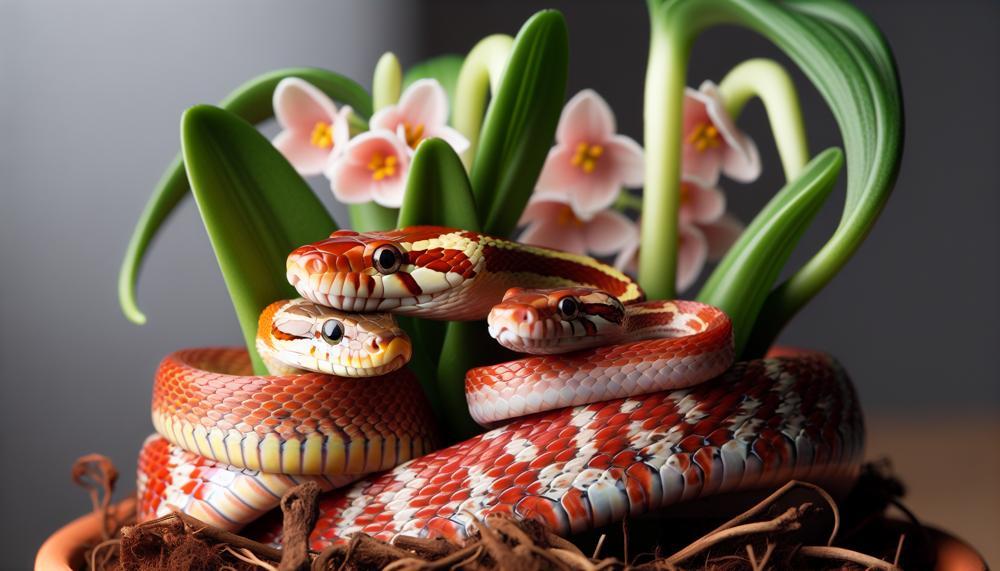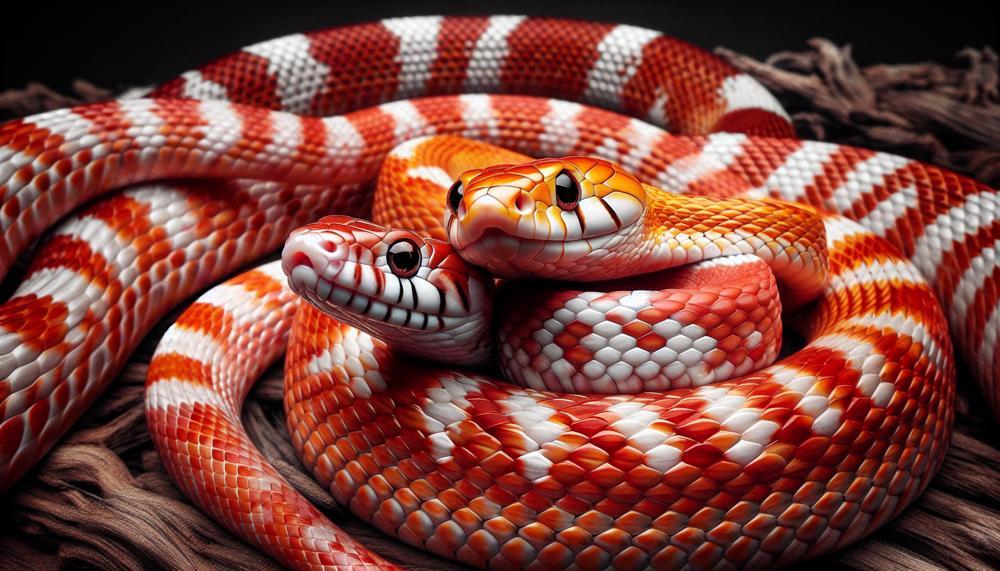Are you thinking about housing corn snakes together? This hot topic in the reptile community has caused quite a stir.
While some swear by it, others caution against potential dangers. As an avid reptile lover, I’ve conducted extensive research and have personal experience with cohabiting corn snakes.
In this blog post, we’ll explore the world of keeping corn snakes together and weigh the pros and cons.
Get ready to dive into compatibility, housing options, and more. Here’s what you can expect to learn:
Corn snakes are solitary animals and should be housed alone. Keeping more than one corn snake in the same habitat can cause stress, aggression, and competition between tankmates. Corn snakes prefer to live alone, only ever coming into contact with others for short periods during breeding season. They have a basic instinct to relish eating other corn snakes.
Corn snakes should be provided with a warm area of the enclosure that is approximately 30-32C. Hiding places should be available, as corn snakes become stressed if they cannot hide. It is important to have a hiding area on each end of the tank.
Corn snake handling should occur least 1-2x weekly, but no more than once daily. Snakes do not require social interaction for their mental health, but handling helps the snake stay tame and can be a good opportunity for exercise as well.
Contents [show]
What do corn snakes eat and how big do they get?
Corn snakes are typically around 4-5 feet in length and can weigh up to 900 grams (2 lbs). However, their size may vary depending on factors like habitat size, temperature, and diet. For optimal growth and health, captive corn snakes should be fed mice once a week.
When considering keeping multiple corn snakes together, it’s essential to provide a spacious enclosure with plenty of hiding spots. It’s recommended to have at least 10 gallons of space per snake. The size and diet of each snake can also impact their ability to coexist peacefully.
Younger corn snakes are more likely to live in harmony compared to adults. Introducing them at a young age and ensuring they are similar in size can prevent aggression. Regular handling from a young age can also reduce stress when handling them as adults.
In terms of diet, monitoring the feeding behavior of each snake is crucial. If necessary, they should be fed separately to avoid aggressive behavior caused by one snake eating more than the others.
Moreover, maintaining a clean and healthy living environment is vital to prevent potential health issues that could lead to aggression or stress. If one snake suddenly dies, it’s essential to remove the carcass, isolate the other snakes and seek advice from a veterinarian.
How many corn snakes can live together in one tank or enclosure, and what is the recommended size for their habitat?
Determining the maximum number of corn snakes that can comfortably inhabit one tank or enclosure depends on various factors, including the size of the tank and the length of the snakes. To ensure a suitable living space for a corn snake, it is recommended to have a tank that is at least as long as the snake itself, with enough width and height for climbing and vertical enrichment.
For instance, if you have two adult corn snakes measuring 4 feet each, a 4x2x2 foot enclosure would be adequate for them to coexist. However, if you have four adult corn snakes, all 4 feet in length, a larger enclosure of 8x2x2 feet would be needed to provide enough room for their size and behavior.
It is crucial to note that while corn snakes can coexist in captivity, it is not advisable to house different species of snakes together. Doing so can cause stress, injuries, and even death for one or more of the snakes.
What kind of substrate should you use in a snake’s tank?
When it comes to selecting the perfect substrate for your corn snake’s tank, it’s crucial to take into consideration their specific needs and the conditions of their natural habitat.
Below are some highly recommended substrates for corn snakes and the reasons behind their suitability:
- Coconut fiber: Made from coconut husks, this type of substrate is well-known for its moisture retention capabilities. It’s an excellent choice for maintaining the ideal humidity levels in your snake’s tank. Additionally, coconut fiber is easy to clean and does not contain any harmful chemicals or toxins.
- Cypress mulch: Another popular option among corn snake owners is cypress mulch. It has high absorbency and a natural scent that attracts corn snakes. This substrate also assists in regulating humidity levels and is safe for your snake to burrow in.
- Aspen shavings: While not the most recommended option, aspen shavings can still be used as a substrate for corn snakes. They are relatively inexpensive and easily accessible, but they can create dust and may not hold moisture as effectively as other options.
- Soil: For those looking to replicate their corn snake’s natural habitat, soil can be a suitable choice. It allows for burrowing and mimics the forest floor where corn snakes are commonly found in the wild. Just ensure that the soil you choose does not contain added fertilizers or chemicals.
Other appropriate substrates for corn snakes include Cypress Mulch, Reptichip, Lignocel, and hemp. It’s essential to avoid substrates such as sand, gravel, or pine shavings, which can be harmful if ingested by your snake.
Are there any other types of snakes that can live with corn snakes?
Yes, there are a few snake species that can live together in the same enclosure with corn snakes.
However, it is crucial to take various factors into consideration before housing different species together, including size, temperament, and habitat requirements.
Suitable Snake Species for Corn Snakes:
Ball Pythons:
Ball pythons are a compatible companion for corn snakes as they have similar environmental needs and are not aggressive towards each other.
Both species require a warm and humid environment, making it easier to maintain their enclosure.
Kingsnakes:
Kingsnakes are another suitable species to live with corn snakes as they have similar dietary and environmental needs.
However, it is important to closely monitor their interactions and provide enough hiding places to ensure they get along well.
Milk Snakes:
Milk snakes are also a suitable companion for corn snakes as they share similar temperaments and dietary requirements.
However, it is important to avoid housing different species of milk snakes together as they can be aggressive towards each other.
Garter Snakes:
Garter snakes can peacefully coexist with corn snakes as long as they are similar in size.
Both species require a diet of smaller rodents and insects, making it easier to care for them together.
Critical Considerations when Housing Different Species Together:
- Size: It is crucial to avoid housing reptiles of significantly different sizes together to prevent potential issues such as aggression or one species overpowering the other.
- Temperament: Reptiles with different temperaments may not be able to coexist peacefully in the same enclosure, leading to stress and potential harm.
- Habitat Requirements: Each reptile species has specific environmental needs that must be met for their health and well-being. It is essential to research these requirements before housing multiple species together.
What are some common health problems that corn snakes may experience?
Although corn snakes are typically strong and healthy creatures, there are certain health concerns that may arise when they are kept alongside other snakes. These potential issues include stress, the transmission of parasites and diseases, and physical harm. Let’s take a closer look at each of these health problems in more detail.
- Stress: As mentioned earlier, corn snakes are solitary animals by nature and prefer to have their own space. When placed with other snakes, they may experience constant stress and anxiety, leading to a weakened immune system and increased susceptibility to illnesses. Additionally, stress can also cause behavioral problems such as loss of appetite and lethargy, which can ultimately impact the snake’s overall health.
- Transmission of Parasites and Diseases: When multiple snakes are housed together, there is a higher risk of spreading parasites and diseases among them. This is because these creatures can easily transmit these health issues through direct contact or by sharing the same water and food sources. Parasites like mites can quickly spread among snakes, causing irritation, anemia, and even death if not treated promptly. Diseases such as respiratory infections can also spread rapidly among a group of snakes, making it challenging to control and treat.
- Physical Harm: Keeping multiple snakes together can also lead to injuries and physical harm. While corn snakes are known for their docile nature, they may become targets for aggression or attacks when housed with more aggressive or larger species. This can result in injuries like bites or scratches, which can become infected if not treated promptly. Furthermore, if the enclosure is not spacious enough for all the snakes to comfortably coexist, there may be instances of accidental harm from fighting over limited resources or space.
Therefore, it is crucial for snake owners to carefully consider these potential health risks before deciding to house multiple corn snakes together in one enclosure.
How long do corn snakes typically live?
The typical lifespan of a corn snake ranges from 6 to 8 years, but with proper care and environment, they have the potential to live up to 20 years or more. In this section, we will discuss the various factors that can impact the lifespan of a corn snake and provide you with tips on how to provide the best care for your scaly companion.
Factors That Can Influence Lifespan:

- Genetics: Similar to humans, genetics play a significant role in determining the lifespan of a corn snake. Some snakes may have a predisposition to certain diseases or health issues that can impact their longevity.
- Diet: A well-balanced and diverse diet is essential for the overall health and lifespan of a corn snake. In their natural habitat, they primarily consume small rodents, but in captivity, they can also be fed frozen mice or rats. It’s crucial to avoid overfeeding as obesity can lead to various health problems.
- Environment: The environment in which a corn snake is kept can greatly impact its lifespan. A suitable enclosure with appropriate temperature, humidity levels, and hiding spots is necessary for their well-being. Female snakes also require a nesting area during breeding season.
- Stress: As mentioned earlier, housing multiple corn snakes together can cause stress and potential harm. Thus, it’s vital to provide each snake with its own space to minimize stressors.
- Veterinary Care: Regular check-ups from a reptile specialist can help identify any health issues early on and ensure your snake receives proper treatment.
Tips for Providing Optimal Care:
- Housing: A glass or plastic tank with a secure lid is recommended for housing a corn snake. The enclosure should be at least 20 gallons for an adult snake, with appropriate substrate and hiding spots.
- Temperature and Humidity: Corn snakes require a temperature gradient in their enclosure, with a warmer side (around 85°F) and a cooler side (around 75°F). Humidity levels should be maintained between 40% to 60%.
- Diet: As mentioned, a varied diet is crucial for the health and lifespan of a corn snake. It’s recommended to feed them once or twice a week, depending on their age and size.
- Handling: While corn snakes can tolerate handling, it’s essential to do so gently and with caution. Avoid handling them for at least 48 hours after feeding, as this can cause stress and potentially lead to regurgitation.
- Cleaning: Regularly cleaning and disinfecting the enclosure is vital for preventing the spread of diseases and parasites.
Also Read: Are Ball Pythons Nocturnal?
Conclusion
In conclusion, the idea of housing corn snakes together may seem appealing, but it’s important to carefully consider the potential risks and drawbacks.
While some snake species can coexist peacefully, it’s crucial to provide a spacious and enriched environment for them to thrive. This includes regularly monitoring their behavior and feeding habits to prevent any aggression or stress.
When caring for corn snakes, providing a suitable enclosure with proper temperature and humidity levels, a balanced diet, and regular veterinary care are essential for their well-being.
It’s imperative to do thorough research and seek expert advice before deciding to house your corn snakes together.






